In the competitive automotive market, subcompact cars and SUVs continue to attract consumers seeking practicality and value. The Dacia Sandero and Hyundai Bayon are two models that stand out, each offering unique features and capabilities. This comparison aims to highlight the key technical aspects and innovations of these vehicles to help potential buyers make an informed decision.
Dacia Sandero vs Hyundai Bayon – Which model is better for everyday use?
Compare performance, boot capacity, efficiency and price at a glance.
Find out which car is the better choice for you – Dacia Sandero or Hyundai Bayon?
Design and Dimensions
The Dacia Sandero boasts a hatchback design that appeals to urban drivers. With dimensions of 4088 mm in length, 1848 mm in width, and a height of 1499 mm, it presents a compact yet spacious profile suited for city driving. In addition, the Sandero's trunk capacity of 328 liters makes it practical for daily use.
On the other hand, the Hyundai Bayon embraces an SUV body type, measuring 4180 mm long, 1775 mm wide, and 1500 mm high. The Bayon's larger trunk capacity of 411 liters offers extra space for cargo, making it an excellent option for those who require more versatility in their vehicle.
Powertrains and Performance
When it comes to engine offerings, the Dacia Sandero provides a range of options, including petrol and LPG engines. The power output varies from 67 HP to 110 HP, allowing buyers to choose based on their driving needs. With a manual or CVT transmission available, the Sandero caters to varied preferences. Acceleration from 0 to 100 km/h ranges between 10 and 16.7 seconds, depending on the selected engine.
In comparison, the Hyundai Bayon is equipped solely with petrol engines, delivering a maximum output of 100 HP. Like the Sandero, it offers both manual and automatic transmission options, with acceleration times ranging from 11.3 to 12.4 seconds. Notably, the Bayon’s 998 cm³ engine makes it comparable to the Sandero in terms of efficiency and power.
Fuel Efficiency
Fuel consumption is a crucial consideration for any buyer. The Dacia Sandero demonstrates impressive efficiency, with fuel consumption figures ranging from 5.2 to 7 L/100 km, depending on the variant. Meanwhile, the Hyundai Bayon records a commendable fuel consumption of just 5.4 L/100 km, making it slightly more fuel-efficient than the Sandero across the board.
Both vehicles fall into similar CO2 efficiency categories, with the Sandero emitting between 105 to 139 g/km and the Bayon registering at 122 g/km. This aspect is increasingly important for environmentally-conscious consumers.
Interior Features and Innovations
Moving to the interiors, both vehicles offer comfortable seating for five passengers. The Dacia Sandero, designed with a focus on practicality, includes essential features with an emphasis on affordability. It promotes user-friendly technology but lacks some of the advanced systems present in pricier competitors.
Conversely, the Hyundai Bayon tends to include more advanced technology and connectivity features, such as a modern infotainment system and safety options that appeal to tech-savvy buyers. Although both models prioritize functionality and passenger comfort, the Bayon provides a more premium feel and additional innovations conducive to a connected driving experience.
Conclusion
In summary, both the Dacia Sandero and Hyundai Bayon cater to distinct segments of the market. The Sandero's affordability, efficient engine options, and compact hatchback design make it an excellent choice for urban drivers. Meanwhile, the Hyundai Bayon offers a more spacious SUV alternative with modern features and superior fuel efficiency.
Ultimately, the decision between the two should consider individual driving habits, preferences for body style, and the importance of technological advancements in a vehicle. Regardless, both the Dacia Sandero and Hyundai Bayon are worthy contenders in the competitive car landscape, providing consumers with exceptional value for their investment.
Here’s where it gets real: The technical differences in detail
Costs and Efficiency:
Price and efficiency are key factors when choosing a car – and this is often where the real differences emerge.
Dacia Sandero has a decisively advantage in terms of price – it starts at 10700 £, while the Hyundai Bayon costs 20100 £. That’s a price difference of around 9352 £.
Fuel consumption also shows a difference: Dacia Sandero manages with 5.30 L and is therefore hardly perceptible more efficient than the Hyundai Bayon with 5.40 L. The difference is about 0.10 L per 100 km.
Engine and Performance:
Power, torque and acceleration say a lot about how a car feels on the road. This is where you see which model delivers more driving dynamics.
When it comes to engine power, the Dacia Sandero has a barely noticeable edge – offering 110 HP compared to 100 HP. That’s roughly 10 HP more horsepower.
In acceleration from 0 to 100 km/h, the Dacia Sandero is a bit quicker – completing the sprint in 10 s, while the Hyundai Bayon takes 11.30 s. That’s about 1.30 s faster.
In terms of top speed, the Dacia Sandero performs barely noticeable better – reaching 183 km/h, while the Hyundai Bayon tops out at 179 km/h. The difference is around 4 km/h.
Both models offer the same torque – 200 Nm.
Space and Everyday Use:
Beyond pure performance, interior space and usability matter most in daily life. This is where you see which car is more practical and versatile.
Both vehicles offer seating for 5 people.
In curb weight, Dacia Sandero is hardly perceptible lighter – 1089 kg compared to 1170 kg. The difference is around 81 kg.
In terms of boot space, the Hyundai Bayon offers evident more room – 411 L compared to 328 L. That’s a difference of about 83 L.
In maximum load capacity, the Hyundai Bayon performs hardly perceptible better – up to 1205 L, which is about 97 L more than the Dacia Sandero.
When it comes to payload, Hyundai Bayon slight takes the win – 465 kg compared to 436 kg. That’s a difference of about 29 kg.
Who wins the race?
The Dacia Sandero proves to be dominates this comparison and therefore becomes our DriveDuel Champion!
Dacia Sandero is the better all-rounder in this comparison.
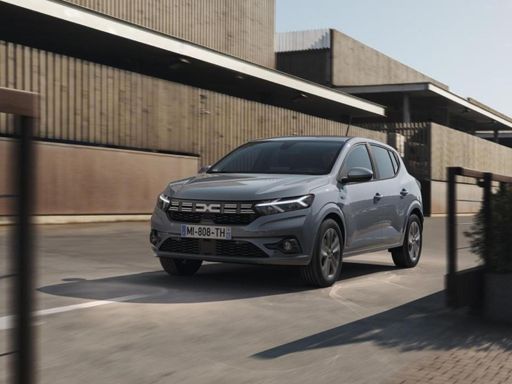 @ Dacia / Renault Group Media
@ Dacia / Renault Group Media
Dacia Sandero
Dacia Sandero
The Dacia Sandero is the everyman's hatchback — unpretentious, practical and brilliantly affordable, with sensible space and straightforward charm where it matters most. It won't wow in the premium lane, but for buyers who want honest, dependable transport without showroom theatrics, the Sandero is a clever, no‑nonsense pick that keeps running costs low and grin levels high.
details @ Dacia / Renault Group Media
@ Dacia / Renault Group Media
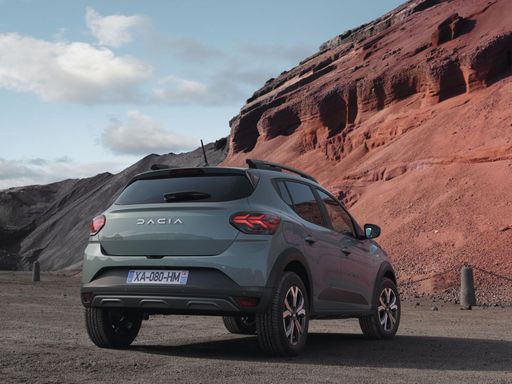 @ Dacia / Renault Group Media
@ Dacia / Renault Group Media
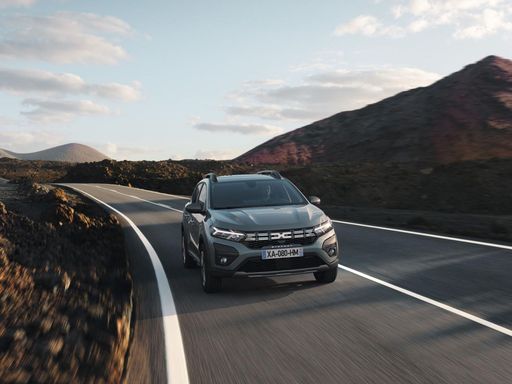 @ Dacia / Renault Group Media
@ Dacia / Renault Group Media
Hyundai Bayon
The Hyundai Bayon slips neatly between city runabout and small SUV, offering surprising practicality and a fresh, confident design that stands out in urban traffic. It's an easy buy for shoppers who want smart packaging, tidy handling and a dash of personality without fuss — a sensible little crossover that makes everyday driving a bit more enjoyable.
details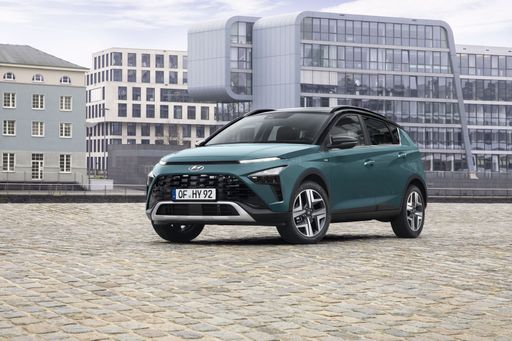 @ Hyundai Motor Company
@ Hyundai Motor Company
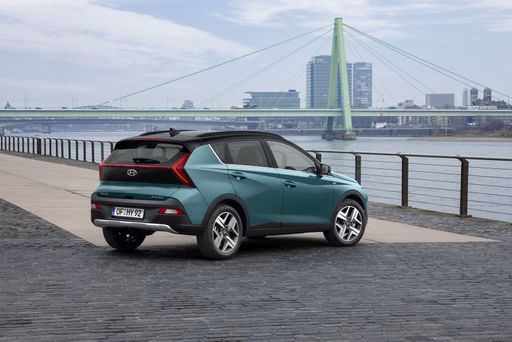 @ Hyundai Motor Company
@ Hyundai Motor Company
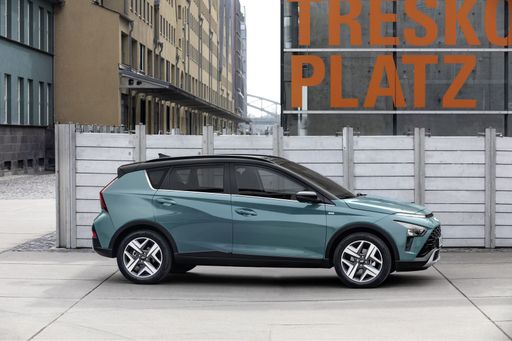 @ Hyundai Motor Company
@ Hyundai Motor Company
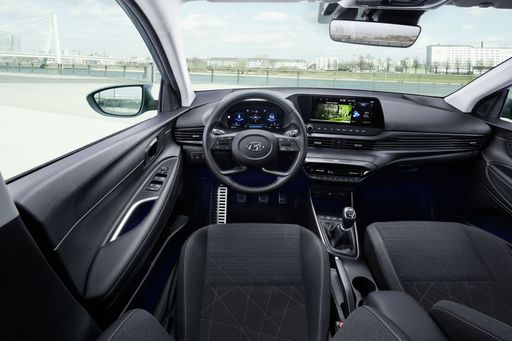 @ Hyundai Motor Company
@ Hyundai Motor Company
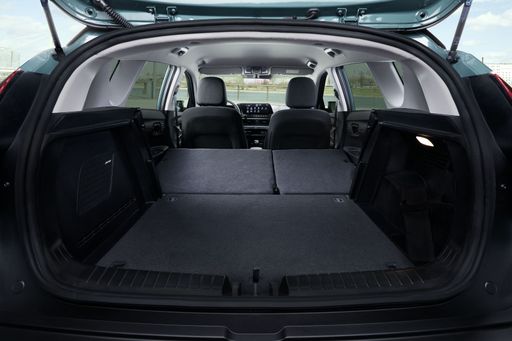 @ Hyundai Motor Company
@ Hyundai Motor Company
 @ Dacia / Renault Group Media
@ Dacia / Renault Group Media
|
 @ Hyundai Motor Company
@ Hyundai Motor Company
|
|
|
|
Costs and Consumption |
|
|---|---|
|
Price
10700 - 16700 £
|
Price
20100 - 25800 £
|
|
Consumption L/100km
5.3 - 7.1 L
|
Consumption L/100km
5.4 - 5.5 L
|
|
Consumption kWh/100km
-
|
Consumption kWh/100km
-
|
|
Electric Range
-
|
Electric Range
-
|
|
Battery Capacity
-
|
Battery Capacity
-
|
|
co2
105 - 140 g/km
|
co2
124 g/km
|
|
Fuel tank capacity
32 - 50 L
|
Fuel tank capacity
40 L
|
Dimensions and Body |
|
|---|---|
|
Body Type
Hatchback
|
Body Type
SUV
|
|
Seats
5
|
Seats
5
|
|
Doors
5
|
Doors
5
|
|
Curb weight
1089 - 1209 kg
|
Curb weight
1170 - 1195 kg
|
|
Trunk capacity
328 L
|
Trunk capacity
411 L
|
|
Length
4088 - 4099 mm
|
Length
4180 mm
|
|
Width
1848 mm
|
Width
1775 mm
|
|
Height
1499 - 1535 mm
|
Height
1500 mm
|
|
Max trunk capacity
1108 L
|
Max trunk capacity
1205 L
|
|
Payload
404 - 436 kg
|
Payload
460 - 465 kg
|
Engine and Performance |
|
|---|---|
|
Engine Type
Petrol, LPG
|
Engine Type
Petrol
|
|
Transmission
Manuel, Automatic
|
Transmission
Manuel, Automatic
|
|
Transmission Detail
Manual Gearbox, CVT
|
Transmission Detail
Manual Gearbox, Dual-Clutch Automatic
|
|
Drive Type
Front-Wheel Drive
|
Drive Type
Front-Wheel Drive
|
|
Power HP
67 - 110 HP
|
Power HP
100 HP
|
|
Acceleration 0-100km/h
10 - 16.7 s
|
Acceleration 0-100km/h
11.3 - 12.4 s
|
|
Max Speed
158 - 183 km/h
|
Max Speed
176 - 179 km/h
|
|
Torque
95 - 200 Nm
|
Torque
172 - 200 Nm
|
|
Number of Cylinders
3
|
Number of Cylinders
3
|
|
Power kW
49 - 81 kW
|
Power kW
74 kW
|
|
Engine capacity
999 cm3
|
Engine capacity
998 cm3
|
General |
|
|---|---|
|
Model Year
2024 - 2025
|
Model Year
2024
|
|
CO2 Efficiency Class
D, C, E
|
CO2 Efficiency Class
D
|
|
Brand
Dacia
|
Brand
Hyundai
|
What drive types are available for the Dacia Sandero?
The Dacia Sandero is available as Front-Wheel Drive.
The prices and data displayed are estimates based on German list prices and may vary by country. This information is not legally binding.
